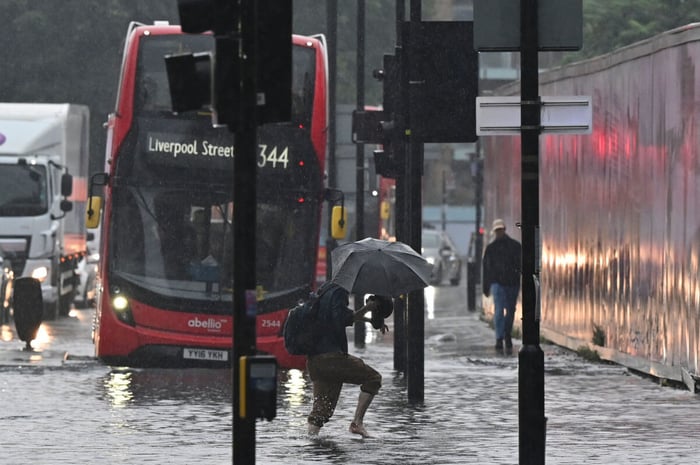According to the recent data from Gov.UK, Londoners are more likely to become victims of floods than any other British residents. Research from Climate Coalition, published last year, comes to the conclusion that London houses are becoming practically unsellable mostly because of the significant risk of flooding or the existing water damage.
Let's take a closer look at why Londoners are facing different sorts of floods more often today and whether there are solutions that could prevent the situation from worsening in the future.

London houses and floods - raw numbers
Before speculating about reasons and possible consequences of such high numbers of floods in London houses. Let's take a look at some statistics to have a clear view of the current situation:
- at least 35% of Londoners claim that their houses have been flooded at least once throughout the time that they have been living there (against 16% all over the UK);
- almost 40% of London Homes are located on a flood plain (against UK average 19%);
- 90% of London homeowners pay much higher insurance premiums due to the flood hazards compared to an average British household.
Recently Climate Change Coalition published a report where they predicted that the situation would only worsen for Londoners in the next 50 years. However, one of the reasons and processes that have led to the current flood risk for London Homeowners are still reversible and can be taken under control if the government, along with the private homeowners, will start acting immediately.
Why London gets flooded more often?
According to experts from the Climate Coalition, global warming is the primary reason why flooding is the most frequent natural disaster worldwide. However, cities like London are even more vulnerable to floods due to rising temperatures and climate change.
Urban areas that contain a lot of glass, concrete and other materials that tend to accumulate heat and prevent free water circulation create the so-called "hot spots" on the map. Water evaporates faster from the surface in those areas. But once it accumulates in the atmosphere and falls down as rain or snow, it cannot absorb directly into the soil due to hard pavement. Eventually, water accumulates and streams to the nearest rivers, creeks, lakes and other water bodies, overflowing them and causing massive floods.
The river Themes is the reason why so much water evaporates from London's surface due to global warming and urbanization, development of industrial areas that force temperatures to rise also cover the soil with concrete and pavement, preventing water from soaking back into the ground.
In other words, London Homes are locked in the vicious circle of urbanization, climate change and global warming that lead to more frequent and destructive floods every year.
Which London areas are more likely to get flooded?
London is a huge city. Sometimes it may rain in one district while the sun is shining at another. However, there are places that get flooded much more often due to various reasons. Over 200,000 households and businesses are located there and become victims of floods regularly:
- Fulham,
- Islington,
- Brent,
- Tower Hamlets,
- Newham
These areas get overheated and flooded much more often. Almost 99% of buildings there has a certain level of water damage that requires constant attention and can influence the quality and safety of living and working there.

Why are London floods more dangerous?
Not only do London homes get flooded more often, but those floods are particularly dangerous. Floods that occur in urban areas and are caused by massive rainfall are usually the so-called "flash floods".
Flash Floods happen and act exactly like they sound: huge masses of water seem to appear from nowhere and literally flash of everything on the way. When water has no place to go, no areas to soak into the ground, it flows directly to the lower points or the nearest water bodies.
Since such rainfalls are often unpredictable, local authorities and residents hardly have time to prepare for flash floods and their impact. The traditional solutions such as dams or sandbagging dikes often appear ineffective. They are either not designed for the increasing masse of water or take too much time for deployment.
How to protect London homes from flooding?
There are several ways London homeowners can protect their properties from flooding. First of all, it is essential to follow warnings and recommendations from local authorities, especially if you live in a flood-prone district of the city.
You should also review your insurance policy and make sure that it covers repairs after the disaster as well as temporary accommodation until your own house becomes safe to live in again.
And, of course, the best way to protect yourself and your property are to find a way to prevent water from getting into it at all.
The modern market offers various solutions, such as temporary flood barriers. They can easily be installed in a matter of several minutes without any additional help or professional assistance. Those flood barriers are strong enough to withstand a 3-foot flood and can be easily adjusted according to the measurements of your house.
Once the water retreats, you can easily remove your flood barrier, fold it and put it aside. They don't take much storage place and can be used multiple times, which makes flood barriers the most sustainable anti-flooding solution on the modern market.
Contact Dam Easy today and learn about Flood Barriers and other modern solutions that will protect your London Home or business from flooding, saving you a great deal of money, effort and sometimes even your life.



